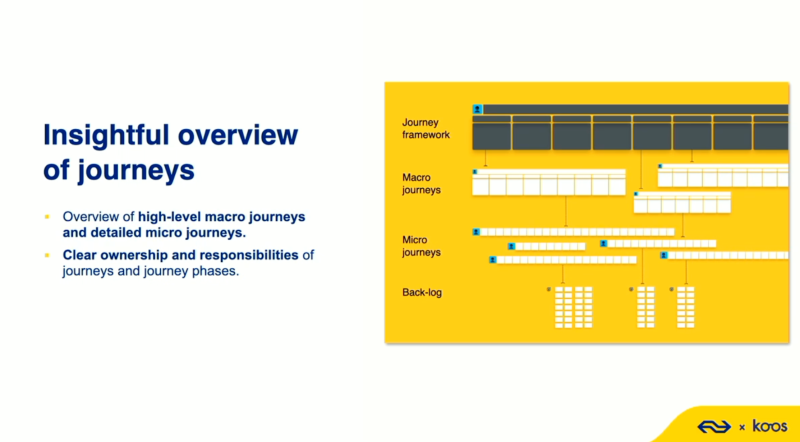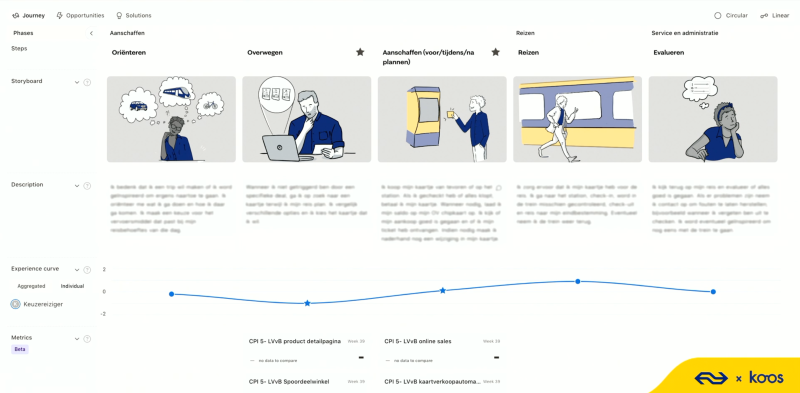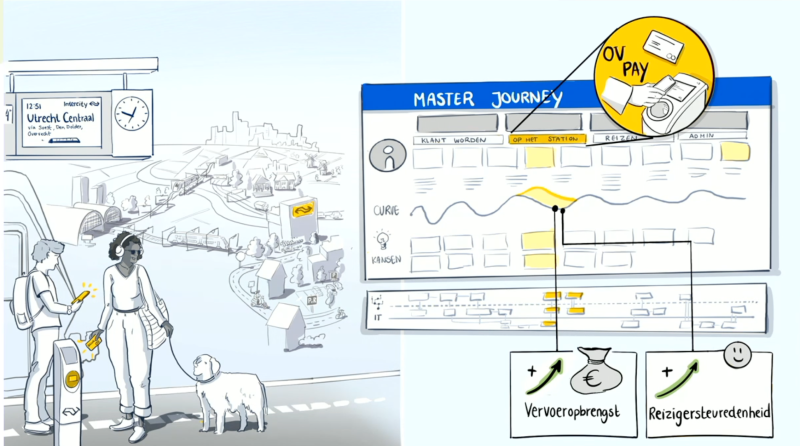
Customer journey management in an agile environment: Case Nederlandse Spoorwegen
Optimally organizing your development teams is a key consideration in large enterprises. Ideally, you want the organization to come together in a way that delivers the best possible business outcomes and a consistent customer experience. Management based on customer journeys is a promising approach that enables excellent customer service by maximizing your company's abilities.
Nederlandse Spoorwegen (NS) is the national railway company in the Netherlands. Peter Cuijpers, the company’s Customer Experience Manager, recently presented at the Service Design Global Conference 2023 in Berlin. Cuijpers shared a story on how they put customer journeys at the center of organizing the company’s efforts. We interviewed him on-site to learn more about how their transformation toward customer journey management happened.

Finding the breakpoint
Nederlandse Spoorwegen is a Dutch national company that has operated for nearly 90 years and employs almost 20,000 people. An organization this large can have a strong resistance to change its ways. However, during the previous decade, NS decided to renew its traditional development model and switch to Agile.
“This breakpoint created an opportunity for us to change how we manage and improve the customer experience. The overall change was huge, but customer journey thinking got a ride on the rails of progress. In about four years, some thirteen teams have adopted the customer journey model”, Cuijpers says.
The organization keeps onboarding new teams to the model as found appropriate.
Why customer journey management helps to create value
Siloes are a recurring issue in large organizations. Teams and departments working independently on connected topics tend to raise borders across their autonomous territory. The flow of information slows down, and consequently, the customer experience suffers from gaps and inconsistencies on the journey caused by poorly aligned service pieces. This compromises the resulting customer experience.
“Journey management takes customer journeys as the focus of the coordinating work. It forces teams contributing to the same journey to share information actively. It ensures that there should be no loose ends or abrupt terminations on any customer journey.”
Peter Cuijpers, Customer Experience Manager at Nederlandse Spoorwegen
In order to succeed, teams must have the incentive and capability to keep user perspective at heart. This is why the development teams at Nederlandse Spoorwegen include individual UX and service designers.
The NS customer journey management model
In practice, customer journey management calls for the unification of tools and practices that an organization uses to manage development.
“The unification alone helps to lower barriers to communication and improves coordination across teams”, Cuijpers says.
Altogether, the NS model includes three primary levels: journey framework, macro journeys, and micro journeys. Micro journeys have clear ownership within the development teams. One team can own up to three micro journeys, and each micro journey feeds into one or more backlogs.

Journeys have a shared documentation and tracking model, so each has shared metrics and similarly presented phases, steps, and storyboards. The journeys live in a dedicated system that is accessible to all teams.

Key takeaways from implementing customer journey management
Cuijpers and Myrthe Montijn, from Nederlandse Spoorwegen’s partner company, Koos Service Design, presented several learnings from switching to the new mode. They specifically dealt with a large organization’s complexity and natural change resistance, leading them to lessons on what is essential in successful change management.
The five takeaways by Cuijpers and Montijn:
- Demonstrate design thinking for internal change management
- Uniform building blocks
- Make the management tools simple and pragmatic
- Celebrate wins but keep going strong
- Dedicate time and head space for the change
The first point is about using design methods to drive the transformation. This includes stakeholder interviews, co-creation workshops, and generally following the iterative process of build, test, and learn – which is why you need to have designers involved.
Unified ways of doing things are crucial in successfully aligning all teams towards mutual goals. Nederlandse Spoorwegen noticed that although teams picked up on the idea of journeys right away, they started implementing them in various ways. The company was able to get things on the right track by providing well-designed journey templates, metrics (business & CX), software tools to deploy them, and a governance model. In order for the management software to be appropriately used, it must be practical and accessible (takeaway 3).
Last but not least, make results visible and known across the organization to keep your teams motivated to stay on the new path. Even though attributing success may not always be straightforward, the change process needs positive reinforcement, as it will take time to see the outcomes fully (takeaways 4 and 5).
External parties that ensure that everything is moving in the right direction can also help facilitate change. Outside facilitation and governance was one of the roles of Koos in Nederlandse Spoorwegen’s process.

The biggest benefits
The most significant gain from the journey management approach was seen recently, in a project involving Tier’s e-bike. The new NS app feature allowed this two-wheeled mode of mobility to be easily booked, planned, and paid for.
“This innovation project was fully customer journey-led in which all participants – designers, product owners, IT architects and partners – used the journey as the ‘boundary object’. The journey approach really helped to get everyone to work from a shared perspective and create a good customer experience”, Cuijpers concludes.
In the Tier e-bike project, the tooling made discussions and decision-making easier and was used to build up the journey.
How to get started with customer journey management
Customer journeys are always a great starting point for the comprehensive management of any product or service experience. It depends on the size of the total service portfolio what is a feasible way to start. If you have a large and complicated organization such as NS, you need to look for a suitable opening in timing and specific starting points.
The larger your organization, the more likely your roadmap will start with a small number of teams and will take a long time to extend to every part of the organization. Starting small is how NS is also managing its transition.
The crucial factor is the presence of design. Before the NS organization transformed, they had no designers to speak of. After the transformation, recruiting designers became possible, paving the way for journey management. This is a challenging way to start because it requires designers to discover their place in the evolving organization and simultaneously establish new working models for everybody! However, this NS example shows that this can be achieved.
Leadership wants to be customer-centric, but it needs designers to show how to do it.





